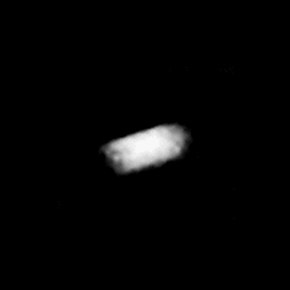Galatea (moon)
 | |
| Discovery | |
|---|---|
| Discovered by | Stephen P. Synnott[1]and Voyager Imaging Team |
| Discovery date | July 1989 |
| Designations | |
Designation | Neptune VI |
| Pronunciation | /ɡæləˈtiːə/[2] |
Named after | ΓαλάτειαGalateia |
| Adjectives | Galatean[3] |
| Orbital characteristics[4][5] | |
| Epoch18 August 1989 | |
| 61952.57 km | |
| Eccentricity | 0.00022 ± 0.00008 |
| 0.42874431 ± 0.00000001 d | |
| Inclination |
|
| Satellite of | Neptune |
| Group | ring shepherd |
| Physical characteristics | |
| Dimensions | (204±10) × (184±16) × (144±8) km[6] |
| 88±4 km[6] | |
| Volume | ~2.8×106km3[a] |
| Mass | 1.94×1018kg[8] |
Meandensity | ~0.69 g/cm3[b] |
| ~0.012–0.025m/s2[c] | |
| ~0.05–0.06 km/s[d] | |
| synchronous | |
| zero | |
| Albedo | 0.08[6][9] |
| Temperature | ~51Kmean (estimate) |
| 21.9[9] | |
Galatea/ɡæləˈtiːə/,also known asNeptune VI,is the fourth-closestinner moonofNeptune.It is named afterGalatea,one of the fiftyNereidsofGreek legend,with whomCyclopsPolyphemuswas vainly in love.
Discovery[edit]

Galatea was discovered in late July 1989 from the images taken by theVoyager 2probe.It was given the temporary designationS/1989 N 4.[10]The discovery was announced (IAUC 4824) on 2 August 1989, and mentions "10 frames taken over 5 days", implying a discovery date of sometime before July 28. The name was given on 16 September 1991.[11]
Physical properties[edit]
Galatea is irregularly shaped and shows no sign of any geological modification. It is likely that it is a rubble pile re-accreted from fragments of Neptune's original satellites, which were smashed up by perturbations fromTritonsoon after that moon's capture into a very eccentric initial orbit.[12]
Orbit[edit]
Galatea's orbit lies below Neptune'ssynchronous orbitradius, so it is slowly spiralling inward due totidal decelerationand may eventually impact the planet or break up into a newplanetary ringsystem upon passing itsRoche limitdue totidal stretching.
Galatea appears to be ashepherd moonfor theAdams ringthat is 1,000 kilometres (620 mi) outside its orbit.Resonanceswith Galatea in the ratio 42:43 are also considered the most likely mechanism for confining the unique ring arcs that exist in this ring.[13]Galatea's mass has been estimated based on the radial perturbations it induces on the ring.[14][7]
Notes[edit]
- ^ Volume derived from the long axisA,the medium axisBand the short axisC:
- ^ Density derived from massmand the volumeV:
- ^ Surface gravity derived from the massm,thegravitational constantGand the radiusr:
- ^ Escape velocity derived from the massm,thegravitational constantGand the radiusr:
Since Galatea is irregularly shaped, the actual surface gravity and escape velocity will vary significantly between different positions on the surface.
References[edit]
- ^ Planet Neptune Datahttp:// princeton.edu/~willman/planetary_systems/Sol/Neptune/
- ^"galatea".Oxford English Dictionary(Online ed.).Oxford University Press.(Subscription orparticipating institution membershiprequired.)
- ^AMIA (1999),Transforming health care through informatics
- ^ Jacobson, R. A.; Owen, W. M. Jr. (2004)."The orbits of the inner Neptunian satellites from Voyager, Earthbased, and Hubble Space Telescope observations".Astronomical Journal.128(3): 1412–1417.Bibcode:2004AJ....128.1412J.doi:10.1086/423037.
- ^Showalter, M. R.; de Pater, I.; Lissauer, J. J.; French, R. S. (2019)."The seventh inner moon of Neptune"(PDF).Nature.566(7744): 350–353.Bibcode:2019Natur.566..350S.doi:10.1038/s41586-019-0909-9.PMC6424524.PMID30787452.
- ^abc Karkoschka, Erich (2003). "Sizes, shapes, and albedos of the inner satellites of Neptune".Icarus.162(2): 400–407.Bibcode:2003Icar..162..400K.doi:10.1016/S0019-1035(03)00002-2.
- ^ab Madeira, Gustavo; Winter, Silvia Maria Giuliatti (2022-04-21)."Numerical analysis of processes for the formation of moonlets confining the arcs of Neptune".Monthly Notices of the Royal Astronomical Society.513(1): 297–309.arXiv:2204.01063.doi:10.1093/mnras/stac944.ISSN0035-8711.
- ^Giuliatti Winter et al. (2020), as cited in Madeira & Giuliatti Winter (2022).[7]
- ^ab"Planetary Satellite Physical Parameters".JPL(Solar System Dynamics). 2008-10-24. Archived fromthe originalon 2013-11-01.Retrieved2008-12-13.
- ^ Marsden, Brian G. (August 2, 1989)."Satellites of Neptune".IAU Circular.4824.Retrieved2011-10-26.
- ^ Marsden, Brian G. (September 16, 1991)."Satellites of Saturn and Neptune".IAU Circular.5347.Retrieved2011-10-26.
- ^ Banfield, Don; Murray, Norm (October 1992). "A dynamical history of the inner Neptunian satellites".Icarus.99(2): 390–401.Bibcode:1992Icar...99..390B.doi:10.1016/0019-1035(92)90155-Z.
- ^ Namouni, F.; Porco, C. (2002)."The confinement of Neptune's ring arcs by the moon Galatea".Nature.417(6884): 45–7.Bibcode:2002Natur.417...45N.doi:10.1038/417045a.PMID11986660.S2CID4430322.
- ^ Porco, C.C. (1991). "An Explanation for Neptune's Ring Arcs".Science.253(5023): 995–1001.Bibcode:1991Sci...253..995P.doi:10.1126/science.253.5023.995.PMID17775342.S2CID742763.







